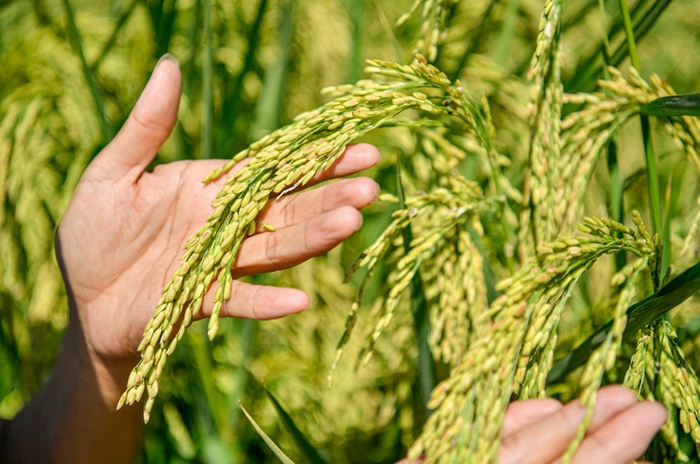[ Xinhua] Chinese scientists unravel mystery of reproductive isolation in rice

A staff member shows the "giant rice", a variety of hybrid rice, in Dongbaizhuang Village of Dongjituo Township, Ninghe District of north China's Tianjin, Sept. 6, 2022. (Xinhua/Sun Fanyue)
BEIJING, July 27 (Xinhua) -- A research breakthrough from Chinese scientists is expected to provide a solution to hybrid sterility encountered in the application of heterosis between indica and japonica rice.
The discovery will facilitate the development of high-yield rice varieties with enhanced resistance to biotic and abiotic stresses to ensure food security.
A research team led by Wan Jianmin, an academician at the Chinese Academy of Engineering, recently uncovered the mystery of how reproductive isolation genes operate to realize hybrid sterility. The team has also revealed the evolutionary trajectory of these genes and their distribution among different germplasm resources, including wild and cultivated rice.
Their findings have been published in the latest issue of the journal Cell.
Scientists say the application of heterosis in crop production is an important strategy to increase productivity significantly.
Cultivated rice in Asia is grouped into two subspecies: indica and japonica. Japonica rice is mostly planted in northern China, and indica rice in southern China.
Since the 1970s, the hybrid rice developed by the well-known late Chinese scientist Yuan Longping has relied on heterosis exhibited by various subspecies of indica rice. The success of indica hybrid rice has enabled a substantial increase in rice production overall, which has made a great contribution to food security in China and around the world.
"Generally speaking, the more distant the genetic relationship between varieties, the stronger the hybrid heterosis. If super hybrid rice can be bred using indica rice and japonica rice subspecies, it is thought that grain yields could increase more than 15 percent when compared to existing hybrid rice," Wan said.
However, there is significant reproductive isolation when indica and japonica rice are cross-bred, and their hybrid varieties often demonstrate hybrid sterility, which is one of the biggest obstacles in the application of heterosis.
The research team analyzed and identified one of the main locus causing pollen sterility when indica and japonica subspecies are cross-bred at the genome-wide level. Genetic analysis revealed that this locus harbors two closely linked genes.
These two genes can be described as "destroyer" and "guardian." The destroyer kills the hybrid plant's pollen, while the guardian protects the pollen from the harmful effects of the destroyer, allowing pollen that inherits the guardian gene to develop normally, said Wang Jian, a key member of the team and a researcher at the Chinese Academy of Agricultural Sciences' Institute of Crop Sciences.
Due to the uneven distribution of this gene pair among rice species and subspecies, pollen sterility is common in cross-breeding. "With the availability of this information, breeders can use molecular marker-assisted selection to predict and attenuate the impact of pollen sterility on their breeding programs, thereby accelerating the development of high-yield varieties," Wang said.
This gene pair functions as a gene drive, meaning genes that determine traits, such as pathogen and pest resistance genes, can be loaded as cargo. Genes stacked on the gene drive are preferentially inherited by offspring and, over generations, they will be spread and become predominant in a population.
This molecular design can be utilized in biotechnology breeding. The Chinese study is a milestone breakthrough in our understanding of the mechanism of hybrid sterility at the molecular level, according to experts.
-
 Apr 18, 2024Opening Ceremony of the Training Workshop on Wheat Head Scab Resistance Breeding and Pest Control in Africa Held in CAAS
Apr 18, 2024Opening Ceremony of the Training Workshop on Wheat Head Scab Resistance Breeding and Pest Control in Africa Held in CAAS -
 Apr 03, 2024IPPCAAS Co-organized the Training Workshop on Management and Application of Biopesticides in Nepal
Apr 03, 2024IPPCAAS Co-organized the Training Workshop on Management and Application of Biopesticides in Nepal -
 Mar 28, 2024Delegation from the School of Agriculture and Food Science of University College Dublin, Ireland Visit to IAS, CAAS
Mar 28, 2024Delegation from the School of Agriculture and Food Science of University College Dublin, Ireland Visit to IAS, CAAS -
 Mar 25, 2024Director of World Food Prize Foundation visited GSCAAS
Mar 25, 2024Director of World Food Prize Foundation visited GSCAAS -
 Mar 20, 2024Institute of Crop Sciences (ICS) and Syngenta Group Global Seeds Advance Collaborative Research in the Seed Industry
Mar 20, 2024Institute of Crop Sciences (ICS) and Syngenta Group Global Seeds Advance Collaborative Research in the Seed Industry
